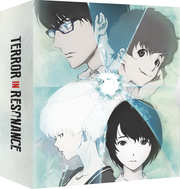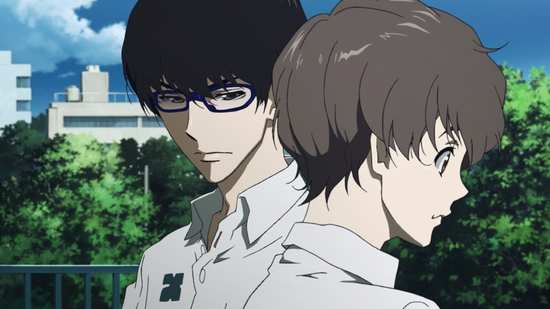Review for Terror in Resonance - Ultimate Edition
Introduction
I’m not too big on names in entertainment. I have to enjoy something first and foremost, and it rarely matters to me who was involved in creating it, especially behind the scenes. But once in a while you get a talent so prolific, so inspired, and so downright brilliant that you wind up seeking out their body of work; the names actually become more significant that than the shows and movies they work on. That’s true when it comes to Yoko Kanno and Shinichiro Watanabe. Watanabe has directed shows like Samurai Champloo, and Space Dandy, and served as music producer on shows like Michiko and Hatchin, and the Woman Called Fujiko Mine. Yoko Kanno has created music for shows like Darker Than Black, Macross Frontier, Ghost in the Shell: Stand Alone Complex, Escaflowne and Wolf’s Rain. It’s all fantastic stuff, but it’s when the two collaborate that things go stratospheric. The first major title directed by Watanabe and scored by Kanno pretty much defined modern anime as we know it, the landmark Cowboy Bebop. It was 14 years before they collaborated again on a TV show, but that was the absolutely sublime Kids on the Slope. It only took another two years following that for them to reunite, but you can bet that I was front and centre in front of my laptop when Terror in Resonance was simulcast, and now that it’s getting the Ultimate Edition treatment from All the Anime, you can bet I’m front and centre for the review discs too. It’s a noitaminA show as well, so you can expect something a little more challenging and thought-provoking than the usual moe-blob of the week series.
The new transfer students Arata Kokonoe and Toji Hisami are more than a little odd, especially so if Lisa Mishima noticed. Lisa is bullied at school, and lives with an abusive and controlling mother at home, so Hisami’s ebullient strangeness and Arata’s coldness are peculiar indeed. Not that they are at school for long. On a school trip to a municipal building, Lisa happens to be in the wrong place at the wrong time when a terrorist incident occurs, and she realises that Arata and Hisami, or rather Nine and Twelve as they refer to themselves, are both responsible. Nine gives her a choice, die or become an accomplice of the Sphinx terrorist group. Ironically, joining the most wanted men in Japan could just be the decision that liberates Lisa, but they aren’t just ideological terrorists, their motives stem from a far more tragic and chilling crime. Certainly the manhunt that ensues following their attack is unprecedented, but understandable given that six months previously, a substantial amount of plutonium was stolen from a nuclear reprocessing facility. But one of the hunters pursuing Nine and Twelve is a figure from their own past.
Eleven episodes of Terror in Resonance are presented across two Blu-ray discs from All the Anime (the Ultimate Edition also has the DVDs), and a standard DVD release will be available separately.
Disc 1
1. Falling
2. Call & Response
3. Search & Destroy
4. Break Through
5. Hide & Seek
6. Ready or Not
7. Deuce
8. My Fair Lady
Disc 2
9. Highs & Lows
10. Helter Skelter
11. VON
Picture
Terror in Resonance gets a 1.78:1 widescreen 1080p transfer, courtesy of Funimation, whose discs All the Anime have repurposed for Region B. I have to say that I don’t think much of the transfer at all, which while it is sharp, and has the requisite high definition pop to it, seems like one of those titles where Funimation have tweaked the brightness settings, shifting thing up a notch in an futile attempt to bring out more detail. Instead things all look a little hazy, with no real contrast in darker scenes, black levels tending to grey at best, and a greater tendency to digital banding, not that this show is overly blighted by it. It’s just that so much of the animation is set in low light conditions, that the lack of detail really tells, the abundance of grey where black should be is off-putting. The thing is that I don’t know if this is Funimation’s doing, or if this is a problem with the source material, and given that streams aren’t accessible anymore, I can’t readily find out. Brighter, daylight scenes show no such issues though.
It’s a shame as Terror in Resonance is a spectacular animation, great character designs, and a level of realism in the locations and settings that approaches photo-real at times. The character animation is studied and nuanced, perfect in conveying emotion, while the action sequences are some of the best I’ve seen in television animation, putting some theatrical productions to shame. People talk about ‘sakuga’, moments in anime where the production quality dramatically improves to sell an emotional point, or enliven the action. The whole of Terror in Resonance is sakuga.
The images in this review were kindly supplied by All the Anime.
Sound
You have the choice between Dolby True HD 5.1 Surround English, and 2.0 Stereo Japanese, with locked in translated English subtitles for the Japanese audio, and a signs and theme song lyrics track for the English audio. I sampled the English dub and found it passable, nothing spectacular, while the surround is certainly appreciated for the show’s action sequences. The dub might actually be preferable for consistency though, as while I did prefer the Japanese audio when it came to the Japanese dialogue, with the cast well suited to their roles, there’s also English dialogue for the ‘native’ English speakers, which is poor indeed to the point of incomprehensibility. These moments have burnt in Japanese subtitles, but Funimation also took the wise choice of adding English subtitles as well. Apparently this time the dubbing studio couldn’t find English ex-pat speakers to dub the roles as they usually do, so we’re subjected to egregious Engrish, as Japanese actors try their best to just phonetically speak the words.
The highlight of this release in terms of audio is the Yoko Kanno soundtrack of course, and once again you have a peerless music experience watching the show. And while the theme songs might not be toe-tappingly catchy, they do suit the tone of the story well. But it’s the incidental music that really succeeds in offering an experience that is decidedly different and refreshing when compared to other, similar genre pieces. It is a show that will have you seeking out the soundtrack CD, which actually is a bone of contention with me.
Extras
The discs present their content with animated menus.
Disc 1 autoplays with a trailer for Noein, but the sole extra on the disc is the audio commentary on episode 1, with ADR director and voice of Nine, Christopher Bevins, and he’s joined by Aaron Dismuke (Twelve), and Jad Saxton (Lisa). It’s a spoilerific commentary that offers some interesting analysis of their characters.
Disc 2 autoplays with a trailer for Ga-Rei Zero. You’ll also find the trailer for Terror in Resonance, as well as other Funimation trailers for Kingdom, Eden of the East, Black Lagoon, Ghost in the Shell Arise: Borders 3 & 4, Dragonball Z: Resurrection F, Tokyo Ghoul, Danganronpa, and The Future Diary.
Someone should tell Funimation that if they list Textless Credits, and then present them with locked subtitles, they aren’t textless! The opening and closing credits are presented thus here.
In Depth Conversation With the Cast lasts 21:46, and features writer Tyson Rinehart, ADR director and voice of Nine, Christopher Bevins, Aaron Dismuke (Twelve), and Rob McCollum (Shibazaki), as they offer their simplistic take on terrorism and modern societies.
Episode 11 Commentary features Christopher Bevins again, Aaron Dismuke, Rob McCollum, and Jeremy Inman (Assistant ADR Director and voice of Hamura). This one is more of the usual Funimation gigglefests.
I haven’t had the physical extras for the Ultimate Edition of Terror in Resonance to go through, but you will get the show on DVD as well as Blu-ray, and large deluxe packaging to hold not only the Amaray case, but the coffee-table hardcover artbook, running to some 100 pages (I saw an unboxing on Youtube and it looks lush).
Conclusion
Terror in Resonance has the best opening episode I have seen in anime since R.O.D. The TV. It leaves you desperate to watch the rest of the series to see what happens next. The show is stupendously well animated, and it goes without saying that the music is peerless. The show’s concept is good, the story is well written, fits together like an intricate jigsaw, and delivers its twists and turns and plot developments with marked assuredness. The characters too are engaging, interesting, and for the most part well-written. It all works like a well-designed, well-oiled machine. And Terror in Resonance isn’t all that good when it comes down to it. It ultimately disappoints with what it accomplishes, and it also falls flat when you compare it to Cowboy Bebop and Kids on the Slope, the previous two Watanabe and Kanno collaborations.
I think it’s because Terror in Resonance is not really what I wanted it to be. I had the suspicion that was the case when I watched it streamed, and now for my second viewing on Blu-ray, that suspicion has been confirmed. I expected, no actively wanted a fictional look at terrorism, some exploration at what causes people to go to such lengths for a cause, commit such horrendous acts of violence on massive scales. Since 2001global terrorism has never been far from news headlines, and it defines our world, the way we live our lives in a way that 20 years ago would have been unthinkable. Our society is increasingly shaped by how we deal with terrorism, we find ourselves accepting morally dubious behaviour from authorities, willingly sacrificing our civil liberties all in the name of increased security, and all these things need to be questioned and challenged. I guess that I wanted a show called Terror in Resonance, from as vaunted a figure as Shinichiro Watanabe to do all this.
Despite its title, Terror in Resonance isn’t really about terrorists; certainly not the ideological terrorists that we face in the real world, or those intent on committing mass murder merely in the name of anarchy. Terror in Resonance has the difficult job of making the terrorists its protagonists, getting us as the audience into their shoes, seeing the world from their viewpoint, and getting us to sympathise with them. It falls at this first hurdle, as these aren’t anarchists intent on knocking the legs out from under the authorities and government, and they aren’t driven by ideology to force the people to see the world the same way they do. They have a far more relatable reason for their actions, revenge, and a justifiable revenge on top of that.
They are also meticulous about avoiding loss of life. They destroy, they disrupt, and they cause terror, but they try to minimise injury, and they even act to save lives. Their mission is to attract attention, to make as big a noise as possible so that they can’t be ignored. It’s the authorities, those tasked with capturing them that aren’t as bothered with breaking a few eggs to achieve their goal. Given Sphinx’ ultimate aims, the wrongs that have been done to them, and the ultimate reveal of just who is responsible, Terror in Resonance loses any shades of grey it might have had in its story, and becomes a simple, black and white tale of right and wrong, good and evil, and as so often happens in these simplistic tales, their enemy turns out to be the very government that is hunting them down, another conspiracy theory about ‘The Man’.
There are also weak elements in the story that detract from the realism for me, although unlike some commentators, I’m not too bothered with the portrayal of Lisa Mishima. Certainly her introduction to the show does make it look like she’ll play a bigger role in the story than she eventually does. Some may call her a wet fish character, but I think her presence is adequate as an audience proxy, a ‘normal’ person let into the blighted world of Nine and Twelve, but also for them she’s a reminder of the human world with which they are interacting, and a physical reminder not to cross certain lines. When they first embroil her in their plans, Nine gives her the choice of becoming their accomplice, or dying. In the end she does neither, but she does become a constant reminder to them that the acts of violence that they are committing do have victims.
It’s actually Five that I have the hardest time accepting in this show, the foe that shows up trying to capture Nine and Twelve, and as you might expect given her name, she had a similar upbringing to them. For one thing, she’s the deranged, psychopath character that serves as an obvious screen villain, she’s willing to cross the lines that Sphinx do not, all so she can win her game with Nine. But she’s also the ‘head’ of the FBI task force that show up in Japan to hunt Sphinx down. So often in anime we get the FBI showing up, or some US department, as if Japan still isn’t a sovereign nation of its own; big bad Americans throwing their weight around as if they still owned the place. As if the Engrish wasn’t bad enough, it’s the lack of realism that shatters my suspension of disbelief.
With any other director, any other animation studio, Terror in Resonance would have been a wholly average and disposable anime, watched and forgotten with ninety percent of the other anime that get streamed to our shores each year. But its creative staff lift it above that mark, the production values are impeccable and the quality of the writing transcends the mediocrity of its premise. It is a silk purse from a sow’s ear, and as such it’s not only a show worth watching, but worth owning as well. The hollow feeling that I had after watching Terror in Resonance wasn’t quite as deep a disappointment as I’ve had with other such anime ‘failures’, and there is still much to recommend this show. But when it comes to terrorism, shows like Eden of the East, Ghost in the Shell: Stand Alone Complex, Mawaru Penguindrum, and Psycho Pass have much more to say, and provoke more in the way of thought.
It is the weakest of the three Watanabe/Kanno shows, and I’d much rather Cowboy Bebop had the Ultimate Edition (never say never, though), and Kids on the Slope deserved far more than the standard release that it got from Sentai and MVM. Right now, the Ultimate Edition is the only way to see Terror in Resonance on Blu-ray, but if you wait until July, All the Anime will release a standard edition of the series. The Ultimate Edition certainly looks lush, but that £99.99 RRP keeps giving me pause. You’ll have to hold the box in your hands, leaf through the artbook to see if it’s worth the extra money that All the Anime are asking for what is an 11-episode show. I just think that with that kind of money, the soundtrack CD should have been in the box as well.





















































Your Opinions and Comments
Be the first to post a comment!